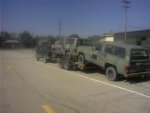My late father had 2 patents on trailer hitches and I did the mathematical modeling (what would be computer simulation today) for them. There are 2 primary factors in towing a trailer:
1. The location of the pivot point (the ball or the pintle) relative to the towing axle. In the case of duel towing axles, use the center between the axles as a reference point.
2. The distance from the pivot point to the axle of the trailer.
First, you want the pivot point to be FORWARD of the towing axle, if at all possible. If it can’t be forward, you want it as close as possible. Look at over-the-road trucks. Except for a few home brew rigs, on a duel axle truck the 5th wheel is mounted between the axles, but closer to the front. In the case of a single axle it is in front of the axle a few inches. To understand why, consider the extreme example, a truck with a long distance from the towing axle to the pivot point (i.e. 26’ rental truck): when the truck starts into a turn, the pivot point initially moves in the opposite direction. If circumstances are right, such as soft sidewalls on tires, etc it can start oscillations. During our studies I researched almost 100 incidents where a crash resulted from an undampened oscillation.
When you setup a “gooseneck” trailer, the ideal position for the hitch is a little forward of the axle, but at least half of the ones I have seen, including “professionally installed” ones, are on top of or behind it. It is a matter of degrees just how important it is. “Professionally installed” just means the guy charged for his services.
Second, you want the distance from the pivot point to the axle of the trailer to be as long as possible. This tends to dampen any oscillations that start. Very often boat trailers tow better than others for this reason. This is also why a gooseneck pivoting behind the axle usually does okay anyway. A gooseneck trailer is usually long with duel axles, both of which help to dampen oscillations.
To the business of duel trailers: UPS hauls lots of double and triple trailers with pintle connections. I have OFTEN followed one where the middle trailer is oscillating. They are apparently able to manage it because the pintle is very close to the axle towing it.
In the case of an ammo trailer the pintle is close to the axle. In the case of an M105 with a pintle added on the back, which to the best of my knowledge the Army has never done, the distance from the axle to the pintle is excessive. It could cause whatever is behind the M105 to oscillate. Because of the size of your truck or the M105 you probably would not even know it or be able to do anything about it if you did.
The only way I know of to stop an undampened oscillation of a trailer is to put the towing vehicle into a shallow turn, count 1 second and hit the brakes hard. Can you imagine doing that in a deuce hauling an M105 and a car dollie?
I appologize if this got a bit long, but I hope this might help someone be a little more safe when setting up trailers.




